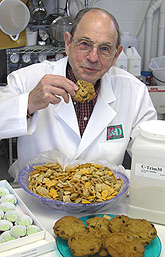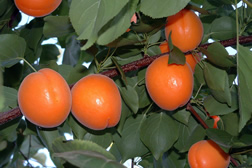| October 2005 |
Orange Oil: Secret Cholesterol Fighter
Oil from orange peels contains compounds that lower blood levels of the "bad" LDL and VLDL cholesterols, studies with laboratory hamsters have revealed.
Agricultural Research Service scientists and co-researchers at KGK Synergize, London, Ontario, Canada, found that effect in tests of peel-based natural chemicals called polymethoxylated flavones, or PMFs.
Hamster feed containing one percent PMFs lowered the animals' blood LDL and VLDL levels by 30 to 40 percent, the scientists report in the Journal of Agricultural and Food Chemistry (volume 52, pages 2879 to 2886). Followup studies will determine whether PMFs have the same effect in humans and, if so, may lead to a profitable new use of juice-processing leftovers.
For details, contact: John A. Manthey, U.S. Citrus and Subtropical Products Laboratory, Winter Haven, Fla. (863) 293-4133, ext. 126.
Whole-Grains Help Artery Health, New Evidence Confirms
Eating six or more servings of whole-grain foods like brown rice or whole-wheat toast every week was associated with slower buildup of artery-narrowing plaque in women already diagnosed with this heart condition.
Researchers at the Jean Mayer USDA Human Nutrition Research Center on Aging at Tufts University, Boston, Mass., analyzed food records and artery-diameter measurements (angiograms) that were taken from 229 postmenopausal women over a 3-year period. An article in a recent issue of the American Heart Journal (volume 150, pages 94 to 101) has details.
America's 2005 Dietary Guidelines recommend eating at least three servings of whole-grain foods every day, but most of us eat less than a single daily serving.
Good sources of whole grains include breakfast cereals made with these grains. Other options: oatmeal, brown rice, barley, popcorn, whole-wheat bread or bagels and bran muffins.
For details, contact: Alice H. Lichtenstein, (617) 556-3127; ARS Jean Mayer USDA Human Nutrition Research Center on Aging at Tufts University, Boston, Mass.
Keeping Just-Cut Cantaloupe Fresh and Flavorful
Freshly cut, ready-to-eat cantaloupe may stay fresh longer, thanks to technologies being developed by ARS scientists at the Southern Regional Research Center, New Orleans, La.
Their approaches aim at short-circuiting the electrical, chemical and hormonal signals that plant cells send to each other when they detect an injury, such as being sliced.
Slicing the fruit while it's held under ultraviolet light or under water, for instance, or exposing it to heat before cutting, thwarts the defense system, to help keep just-sliced fruit crisp and flavorful (Journal of Food Science, volume 70, pages C53 to C57).
For details, contact: Olusola Lamikanra, (215) 836-6913; c/o USDA-ARS Eastern Regional Research Center, Wyndmoor, Pa.
Making Melons More Nutritious Than Ever
|
Spraying potassium, an essential nutrient, on honeydew melons and cantaloupes as they grow boosts the fruits' sweetness as well as levels of potassium, vitamin C and beta-carotene (which the body uses to make vitamin A).
Scientists with the ARS Kika de la Garza Subtropical Agricultural Research Center, Weslaco, Texas, and their coinvestigators also found that adding calcium to the potassium spray improves the plants' ability to resist attack by diseases, makes melons firmer and increases the length of time the fruit can be stored without becoming mushy (Journal of the American Society for Horticultural Science, volume 130, pages 649 to 653).
For details, contact: Gene E. Lester, (956) 447-6322; USDA-ARS Kika de la Garza Subtropical Agricultural Research Center, Weslaco, Texas.
For Crisp, Firm Watermelon, Grafting Helps
Watermelon that's sliced into chunks and sold ready-to-eat needs to stay firm and crisp. The best watermelons for these fresh-cut products might be those that have been grafted to the rootstocks of either of two close relatives--gourds or squashes.
Grafting watermelons isn't a new idea. But researchers at the ARS South Central Agricultural Research Laboratory, Lane, Okla., and their university colleagues are taking a new look at it.
They found that grafted melons were 25 to 30 percent firmer than their nongrafted counterparts.
For details, contact: Benny A. Bruton, (580) 889-7395, ext. 237; USDA-ARS South Central Agricultural Research Laboratory, Lane, Okla.
Alaska Native, American Indian Foods Analyzed
|
Nutrients in caribou, seal, brined salmon, mutton stew and other traditional foods commonly eaten by Alaska Natives or American Indians now are being analyzed meticulously by ARS Beltsville (Md.) Human Nutrition Research Center scientists. Their assays of the vitamins, minerals, calories and other components of these ethnic cuisines will be presented next year in a new, specialized compendium--USDA American Indian and Alaska Native Foods Database,
Dietitians, physicians and other healthcare professionals can use the database to help their patients plan healthful meals and lower their risk of obesity and diabetes.
ARS and the U.S. Department of Health and Human Services’ Indian Health Service and Office of Research on Minority Health are funding the project.
For details, contact: Pamela R. Pehrsson, (301) 504-0716; USDA-ARS Beltsville Human Nutrition Research Center, Beltsville, Md.
Bigger Rainbow Trout Fillets Ahead!
Rainbow trout that yield low-calorie, 8- to 10-ounce dinner fillets--the size many shoppers seek--should now be easier for fish farmers to produce.
The secret?
Reliable, efficient breeding of trout with four sets of chromosomes, needed for mating with trout with the usual two sets. Their fast-growing offspring are sexually sterile. So, food energy that would otherwise be used for mating is instead converted into tender meat that we can grill, broil, bake, poach or fry to perfection.
Researchers based in Leetown, W.Va., at the ARS Center for Cool and Cold Water Aquaculture, and their collaborators improved production of the four- chromosome parents using precision, high-pressure treatment of trout embryos very early in development (Journalof the World Aquaculture Society, volume 36, pages 96 to 102).
For information, contact: William K. Hershberger, (304) 724-8340, ext.2101; USDA-ARS National Center for Cool and Cold Water Aquaculture, Leetown, W.Va.
New "Calorie-Trim" Adds Fiber, Cuts Calories
|
Adding "Calorie-Trim" to cookies, peanut butter, chocolate candies and other foods can cut calories and fat, while at the same time providing beta-glucan, a healthful fiber.
Derived from whole oats and barley, Calorie-Trim, or "C-Trim" for short, contains 20 to 50 percent beta-glucan from these grains.
C-Trim mimics some of the pleasing properties of fat and carbohydrates in foods without loading the body with the excess calories, according to C-Trim's developer at the ARS National Center for Agricultural Utilization Research, Peoria, Ill. And, in animal studies, C-Trim helped control blood-sugar levels and lowered blood cholesterol.
FutureCeuticals of Momence, Ill., has licensed the technology.
For details, contact: George E. Inglett, (309) 681-6363; USDA-ARS National Center for Agricultural Utilization Research, Peoria, Ill.
Colorful Wraps Add Nutrients, Appeal, to Sushi-Style Delicacies
|
Sushi fillings might soon be encircled with brightly colored wraps made not from the traditional seaweed but instead from other vegetables--or fruits. Infrared drying and other leading-edge technologies are key to creating the new wraps.
The new wraps can enhance the flavors and textures of familiar sushi fillings as well as trendy, American-style sushi delicacies. Agricultural Research Service scientists based at the Western Regional Research Center, Albany, Calif., and research partner Origami Foods LLC, Pleasanton, Calif., are experimenting, for instance, with a bright-orange, carrot-based wrap to hold a cucumber, garlic and rice filling; and a deep-red, tomato and basil wrap for a spicy tuna and rice filling.
The sushi-style treats are ideal for weight-conscious Americans trying to eat smaller-size servings.
For details, contact:Tara H. McHugh, (510) 559-5864; USDA-ARS Western Regional Research Center, Albany, Calif.
|
Testing Your Zinc: Is ZIP1 Best?
Zinc in our bodies might best be measured with a test based on the activity of a gene called ZIP1. Right now, physicians and nutrition researchers don't have a zinc test that's easy to use, sensitive and reliable.
But the activity of the ZIP1 gene in our white blood cells might be inversely correlated with our zinc, levels. Scientists with the ARS Western Human Nutrition Research Center, Davis, Calif., and their colleagues reported this in a 2004 issue of the Journal ofNutrition (volume 134, pages 1716 to 1723).
The ZIP1 gene contains instructions that cells use to form a protein of the same name. When a cell needs zinc, the protein can shuttle the mineral from the bloodstream, through the cell membrane and into the cell.
An experiment with 25 healthy females, aged 20 to 25 or 64 to 75, showed that the ZIP1 gene was less active in the white blood cells of volunteers who received an ample supply of zinc--by taking a 22-milligram zinc supplement every day--than in blood samples from those who did not take the supplement.
For more information, contact: Liping Huang, (530) 754-5756; USDA-ARS Western Human Nutrition Research Center, Davis, Calif.
Historic "Carolina Gold" Rice Revived by Researchers
|
Carolina Gold, an heirloom American rice that was widely sought after in the 1700s, has been brought back to growers.
Agricultural Research Service rice breeders in Beaumont, Texas, determined that a distinctive piece of rice DNA known as RM190 can be used to reliably and rapidly differentiate Carolina Gold and its derivatives from some 1,600 other kinds of rice. The work led to breeding of a new, purified variety named "Carolina Gold Select," now being grown in Texas.
For details, contact: Anna M. McClung, (409) 752-5221, ext. 2234; USDA-ARS Rice Research Unit, Beaumont, Texas.
"Shenandoah" Pear Tastes Great, Resists Fireblight
|
Sweet and juicy, Shenandoah pear boasts an appealing taste and texture, stores well--if properly chilled--for about four months, and fends off attack by fireblight, a major bacterial disease of pears.
Shenandoah can be grown in all pear-producing regions of the United States, but will be especially desirable in areas where fireblight is prevalent--the East, Southeast and Midwest. There, Shenandoah trees are ready to harvest from mid- to late September.
Scientists at the ARS Appalachian Fruit Research Station in Kearneysville, W.Va., put Shenandoah through about 20 years of rigorous testing before making it available to plant breeders and others in 2004 (HortScience, volume 39, page 805).
For details contact: Richard L. Bell, (304) 725-3451, ext. 353; USDA-ARS Appalachian Fruit Research Station, Kearneysville, W.Va.
Delectable "Kettleman" Apricots Will Delight Apricot Aficionados
|
Juicy, sweet-tart apricots called Kettleman may soon begin showing up in supermarkets nationwide. The apricot is the newest in a series of delicious
tree fruits from Agricultural Research Service scientists based in Parlier, Calif.
The new fruit’s attractive deep-orange skin, pleasing taste, smooth texture, alluring aroma and early-season availability should make it a success with apricot fans.
Scientists tested more than 1,000 Kettleman trees and fruit before making the new apricot available to breeders, researchers and fruit growers in 2005.
For details, contact: Craig A. Ledbetter, (559) 596-2817; USDA-ARS San Joaquin Valley Agricultural Sciences Center, Parlier, Calif.
Exotic Black Lentils Offer Intriguing New Compound
|
Beluga black lentils, named for the glistening Beluga caviar that they resemble, contain a previously unknown, natural pigment called an anthocyanin, Agricultural Research Service scientists at the Western Regional Research Center, Albany, Calif., have discovered. Now the researchers want to determine if, like some other anthocyanins, this new one enhances our health.
The scientists describe the compound--delphinidin-3-O-(2-O-beta-D- glucopyranosyl-alpha-L-arabinopyranoside)--in a 2005 issue of the Journal of Agricultural and Food Chemistry (volume 53, pages 4932 to 4937). This lentil and other legumes are candidate ingredients for tasty, fiber-rich, low- calorie snacks for tomorrow.
For details, contact: Gary R. Takeoka, (510) 559-5668; USDA-ARS Western Regional Research Center, Albany, Calif.
America's Newest Nutrition "Report Card" Now on the Web
|
If you're shorting yourself on vitamins C, E and perhaps other essential nutrients, as well, you're not alone, America’s newest “nutrition report card” reveals.
Formally titled, "What We Eat in America, NHANES 2001-2002: Usual Nutrient Intakes From Food Compared to Dietary Reference Intakes," it’s available at www.ars.usda.gov/foodsurvey.
ARS experts based at the Beltsville (Md.) Human Nutrition Research Center direct the food-consumption interviews of some 6,000 survey participants nationwide. The researchers developed science-based strategies to streamline the interviews while at the same time increasing the accuracy and reliability of the information gathered.
For details, contact: Alanna J. Moshfegh, (301) 504-0170; USDA-ARS Beltsville Human Nutrition Research Center, Beltsville, Md.
The U.S. Department of Agriculture (USDA) prohibits discrimination in all its programs and activities on the basis of race, color, national origin, age, disability, and where applicable, sex, marital status, familial status, parental status, religion, sexual orientation, genetic information, political beliefs, reprisal, or because all or part of an individual's income is derived from any public assistance program. (Not all prohibited bases apply to all programs.) Persons with disabilities who require alternative means for communication of program information (Braille, large print, audiotape, etc.) should contact USDA's TARGET Center at (202) 720-2600 (voice and TDD). To file a complaint of discrimination, write to USDA, Director, Office of Civil Rights, 1400 Independence Avenue, S.W., Washington, D.C. 20250-9410, or call (800) 795-3272 (voice) or (202) 720-6382 (TDD). USDA is an equal opportunity provider and employer. |
















